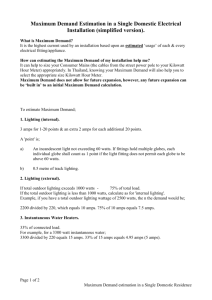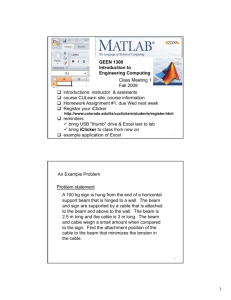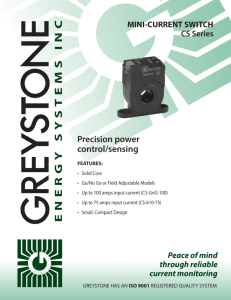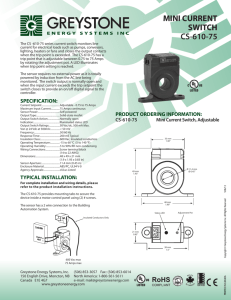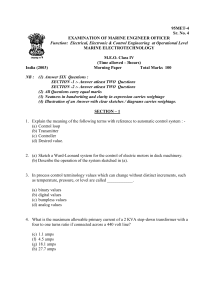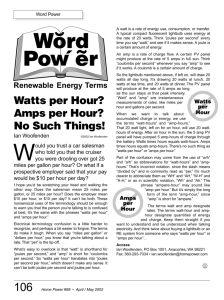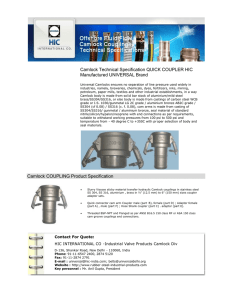Electrics Study Guide
advertisement
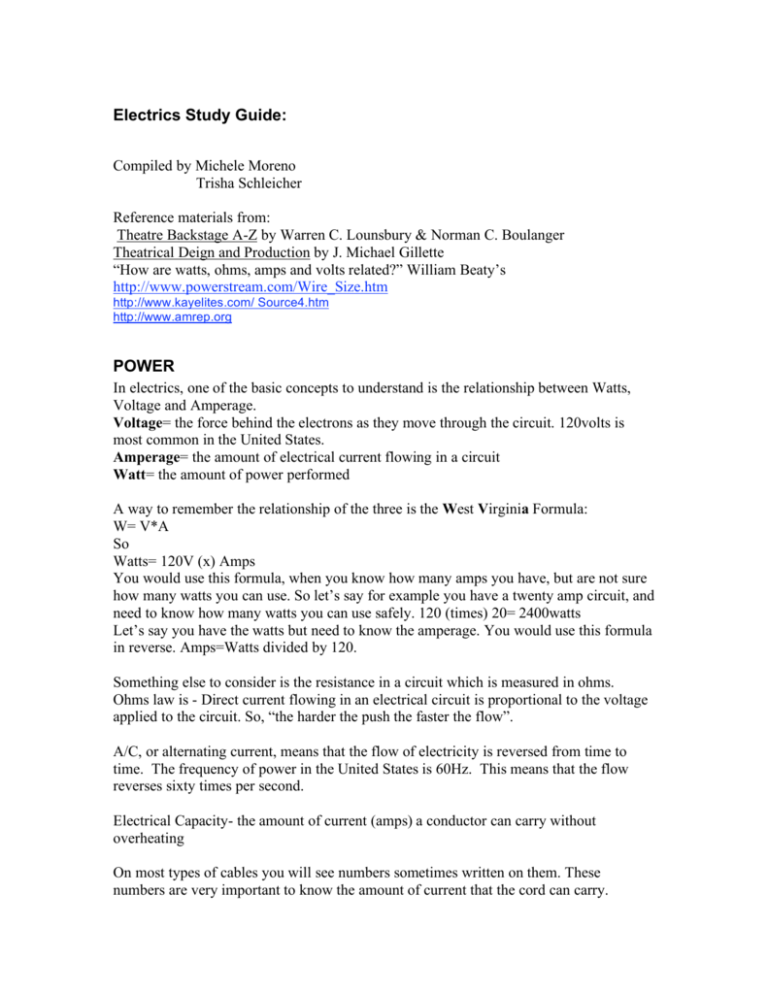
Electrics Study Guide: Compiled by Michele Moreno Trisha Schleicher Reference materials from: Theatre Backstage A-Z by Warren C. Lounsbury & Norman C. Boulanger Theatrical Deign and Production by J. Michael Gillette “How are watts, ohms, amps and volts related?” William Beaty’s http://www.powerstream.com/Wire_Size.htm http://www.kayelites.com/ Source4.htm http://www.amrep.org POWER In electrics, one of the basic concepts to understand is the relationship between Watts, Voltage and Amperage. Voltage= the force behind the electrons as they move through the circuit. 120volts is most common in the United States. Amperage= the amount of electrical current flowing in a circuit Watt= the amount of power performed A way to remember the relationship of the three is the West Virginia Formula: W= V*A So Watts= 120V (x) Amps You would use this formula, when you know how many amps you have, but are not sure how many watts you can use. So let’s say for example you have a twenty amp circuit, and need to know how many watts you can use safely. 120 (times) 20= 2400watts Let’s say you have the watts but need to know the amperage. You would use this formula in reverse. Amps=Watts divided by 120. Something else to consider is the resistance in a circuit which is measured in ohms. Ohms law is - Direct current flowing in an electrical circuit is proportional to the voltage applied to the circuit. So, “the harder the push the faster the flow”. A/C, or alternating current, means that the flow of electricity is reversed from time to time. The frequency of power in the United States is 60Hz. This means that the flow reverses sixty times per second. Electrical Capacity- the amount of current (amps) a conductor can carry without overheating On most types of cables you will see numbers sometimes written on them. These numbers are very important to know the amount of current that the cord can carry. For example: #14/3. These numbers represent the gauge of the cable and the amount of conductors. So in the term #14/3SJ, the cable is a #14 gauge cable with 3 conductors. (Hot, Neutral, Ground) The SJ refers to the cable assembly. Some examples of common assembly annotations include: S = Service Cord (600 Volt standard if no J present) J = Junior Service - 300 Volt T = Thermoplastic E = Elastomer - thermoplastic that looks and feels like rubber O = Oil Resistant Outer Jacket OO = Oil Resistant Outer Jacket and Oil Resistant Conductor Insulation W = CSA Weather and Water Resistant (approved for indoor and outdoor use) According to the American Wire Gauge, each sized cable can safely carry a certain amount of amps. For example: #18/3 = 5 amps #16/3 = 10 amps #14/3 = 15 amps #12/3 = 20 amps #10/3 = 30 amps As you can see, the higher numbered cable, the less capacity it has. 2/0 1/0 0 #4 #12 #18 big----------------------small When the # reaches 0, instead of using (-), There is a 0 added: 1/0 or 0 = 150 amps 2/0 or 00 = 190 amps 4/0 or 0000 = 302 amps Some of the most common connectors used in theaters are listed below: Stage Pin Twist Lock Parallel Blade (Edison) Camlock 20amp Stage Pin: These plugs are found on most conventional lighting fixtures. The center pin is connected to the ground wire. The pin closest to the ground is the neutral, and the remaining pin is the hot. Note: on a 60amp connector, the ground and neutral are reversed. Twist lock: These plugs are used in different capacities. You may find twist lock connectors on moving light fixtures, motor power and motor control. Pin configurations and sizes vary by number of conductors and amperage. Check the top of the plug for ratings. In the illustration to the right, the L-shaped pin is the ground, the silver pin is the neutral. Edison Cable, Parallel Blade, A/C: These plugs are the most recognizable. And you may often see them without the rounded ground pin. CAMLOCK Camlock, or feeder, is used heavily in power distribution. They are large, single-conductor rubberinsulated cables. When connecting camlock cables, always start with the GREEN cable. This cable is the ground. After connecting the green, move on to connecting the white cable (this is the neutral). After that the three hot legs, (red black and blue) can be connected in any order. It is important to remember when removing the cables, do the process in reverse. Disconnect the 3 hot legs, then the white and the ground last. Metering power- when metering between different legs on a 3 phase Camlock system, here are the results: The measurement between 2 hot legs should = 208 volts The measurement between the ground and the neutral should = 0 volts The measurement between the ground and a hot leg, or a neutral leg and a hot leg should be 120volts Some Electrics terms and phases to remember : ACL- Aircraft landing light NEC– National Electrical Code- Produced by the National Fire Protection Association, that regulates wiring practices Electrical Circuit- a wire or bar used to transmit electricity Drop Box- an electrical plug in or junction box dropped from overhead via a spot line AWG- American Wire Gauge- A standard measurement for wire conductor Doghouse- a power distribution box with three separate 20amp circuits. Twofer- a cable with one male end and two female ends for the purpose of powering two lamps from a single circuit. Primary colors in light= Red Green Blue Secondary colors= cyan, yellow, magenta In light, the combination of all color =white In light, the absence of all color = black 3 things needed to focus lights- gloves, c-wrench, and circuit tester Why do you figure eight cables- to cancel the electromagnetic field 6 major types of lights commonly found in the theatre 1- ERS (Ellipsoidal Reflector Spot) 2- PAR (Parabolic Aluminized Reflector) 3- Follow Spots 4- Scoops 5- Boarder Lights or Strip Lights 6- Fresnels 1-ERS: Ellipsoidals are often used as specials because there is much more control over the focus. These lighting instruments are unique because they have shutters and focusable lenses. They can also handle a number of accessories including gobos or patterns, iris kits, film loops, etc. Common ERSs include Altman’s 360s, Strand’s Lekos, and ETC’s Source 4s. A label such as “36-degree” means that the angle of the beam spread is 36 degrees. Logically, a Source 4 19degree will produce a smaller beam than a Source 4 36degree. A label such as “6 by 9” indicates that the ERS has a lens that is 6inches in diameter and a focal length of roughly 9inches. A 6x12 has the same size lens, but a longer focal length. Tip: The beam of light from a 6x9 is similar in size to a 36-degree. The beam of light from a 6x12 is similar in size to a 26-degree. The beam of light from a 6x16 is similar in size to a 19-degree. www.amrep.org 2-PAR: Parabolic Aluminized Reflector. Pars are often used as wash lights because they produce a beam with a soft edge. PARcan Source 4 Par 3- Follow Spots: Douser- A cut off device in a follow spot used to cut the beam of light LIGHT PLOTS KEY Typically, the instrument number will be drawn inside the fixture. Any information about color will be found in front of the fixture, and channel information will be at the back of the fixture. Final Draft of a Light Plot



